This traditional Sicilian pignolata recipe is simple and so easy to make with only 7 ingredients! Also known as honey balls, this classic Sicilian dessert is a must on Christmas Eve. Check out my instructions for a variation on the common ball shaped pignolata and transform this dough into lovely braided rings just like my nonna used to make! 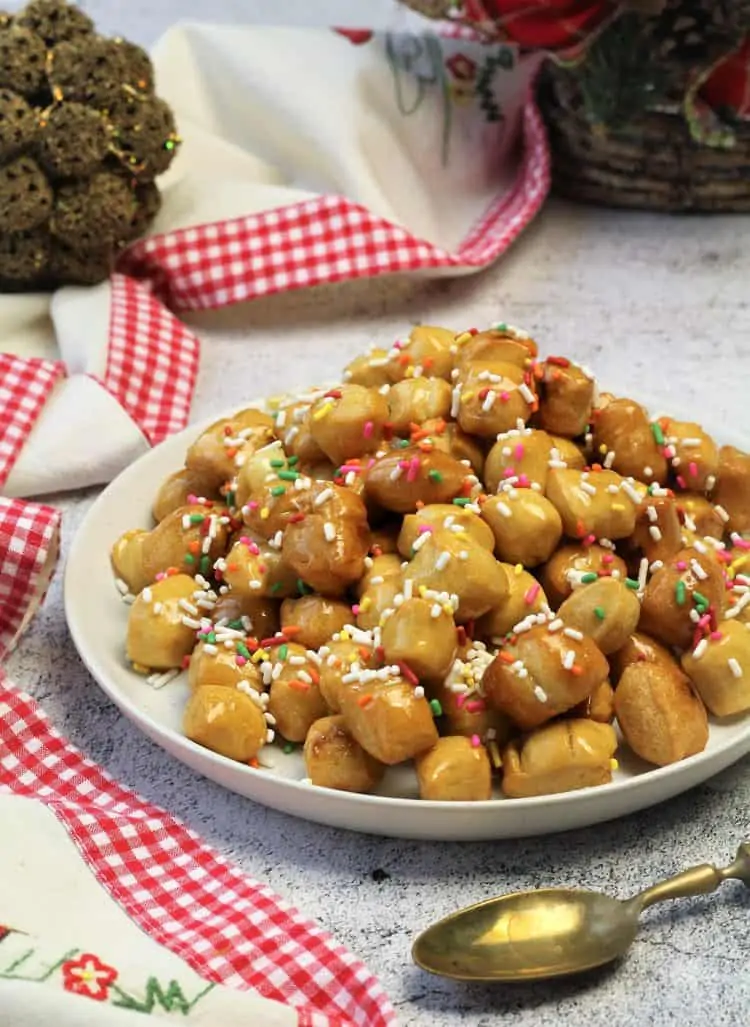
Christmas Eve is simply not complete without pignolata for dessert. Pignolata is a classic Sicilian dessert also known as honey balls. It consists of fried dough balls drenched in honey with a crisp texture on the outside and tender on the inside. Just like eating chips, it's hard to stop after only one bite!
There are without a doubt countless pignolata recipe variations found throughout Sicily. One of these includes the one my cousin in Sicily shared with me here made with semolina flour, grappa and even cinnamon. Although not traditional, semolina flour offers great texture and cinnamon and grappa add a distinct flavor to this pignolata recipe.
My search for this traditional Christmas dessert recipe!
So I'll call my cousin's recipe the modern pignolata recipe since I was clearly informed by my mother that this is not the traditional recipe of her youth. The pignolata that my nonna prepared was much more simple and made with few ingredients. As my mom told me countless times, who had grappa back in Sicily when she was a child?
But more important, my mom recalled how my nonna prepared braided pignolata rings. Certainly not very common, however this lovely braided pignolata is beautiful and has a wonderful crisp and flaky texture. I'll show you further below in this post how to prepare it.
And so after much recipe testing along with my mother's help, here is the traditional pignolata recipe I am sharing with you. First, let me tell you why you need to try out this recipe!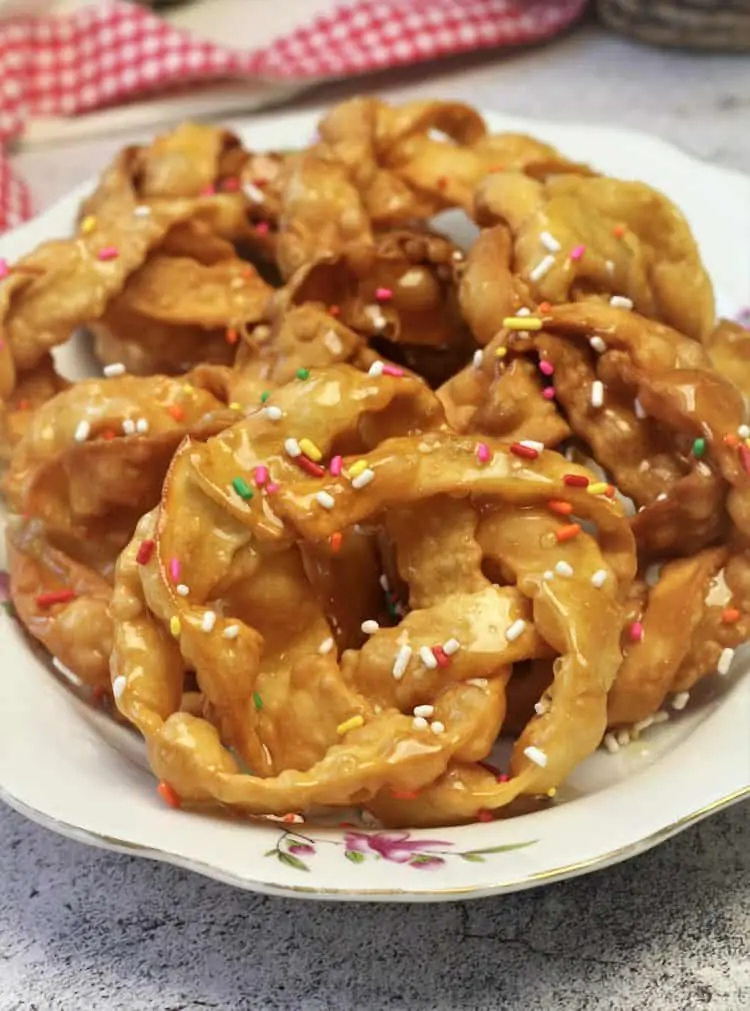
Why is this the best traditional Sicilian pignolata recipe?
- Because it is so easy to prepare. You can make a batch in less than an hour (resting period aside).
- It is made with only only 7 ingredients, plus the colored candy sprinkles for serving.
- Just a touch of milk (1 tbsp. for the whole recipe) results in pignolata that is slightly crisp on the outside but tender on the inside.
- And finally, this dough can be flattened with a pasta roller, cut into strips and braided to make a unique shaped pignolata just like my nonna made!
Ingredient list:
- All-purpose flour
- Granulated sugar
- Salt
- Eggs: I use large sized eggs
- Vegetable oil: can also be replaced with olive oil if you prefer
- Milk: just a tiny bit (1 tbsp.) for pignolata that is tender on the inside.
- Vegetable oil: or avocado oil for frying
- Honey: warmed until liquefied for tossing the fried pignolata in
- Colored candy sprinkles: to turn pignolata into a lovely festive dish!
The following are step by step instructions with images to guide you through this recipe. Please scroll to the end of this post for the detailed, printable recipe card.
Step by Step Instructions:
Prepare the dough:
Make a well in the center and add eggs; vegetable oil and milk.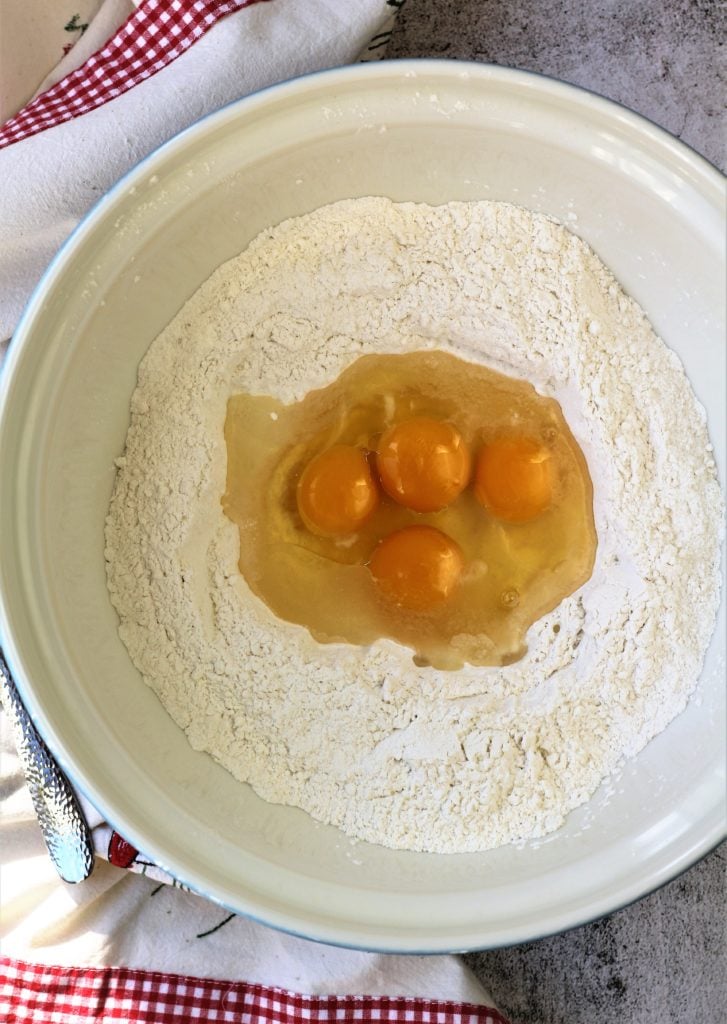
Use a fork to beat the eggs and slowly incorporate the flour into the wet ingredients until a raggedy dough is shaped.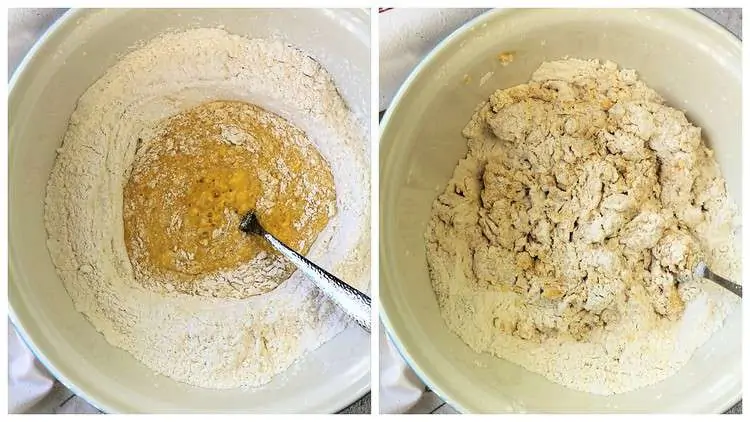
Transfer to your counter and knead until a smooth dough is formed, a minute or two. Cover and let rest at room temperature for 30 minutes.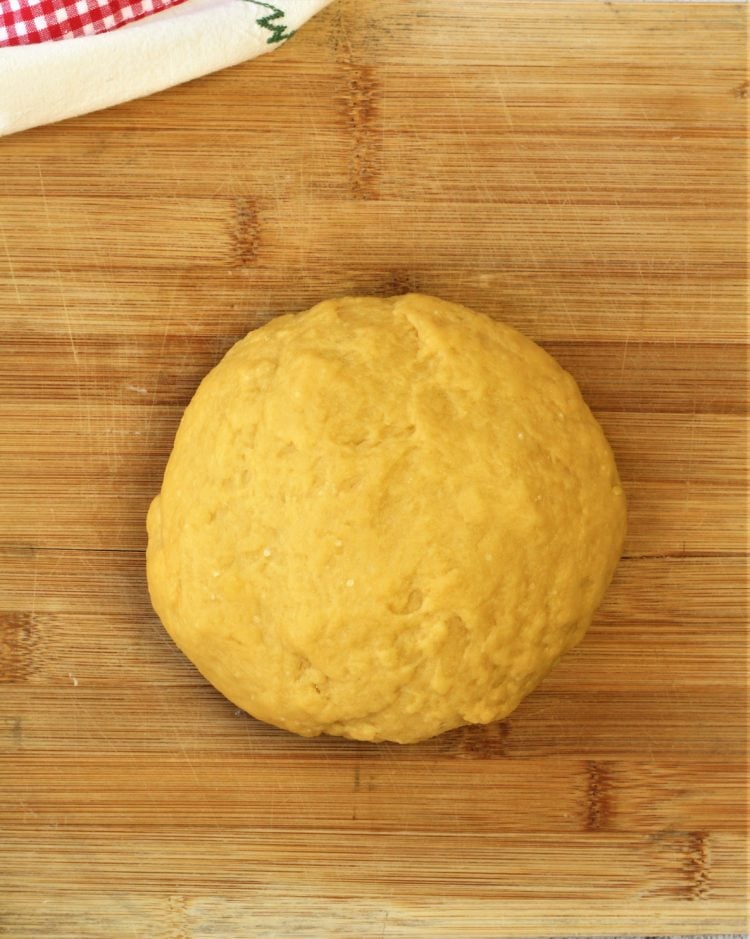
To shape:
Traditional method:
Divide the dough into 4 pieces. Roll into long ropes (as you would for making gnocchi) of about 1 cm thickness. Cut into 1 cm pieces. Leave the pieces as is or if you prefer, roll into a ball.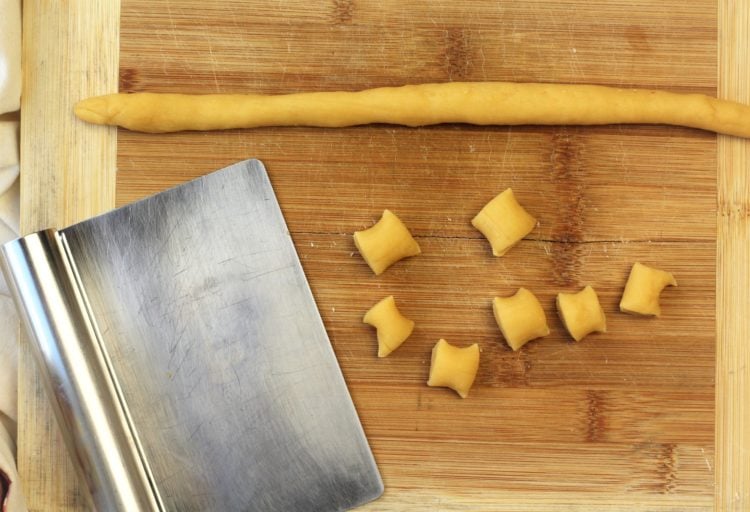
Transfer onto a baking sheet without overlapping to prevent from sticking together.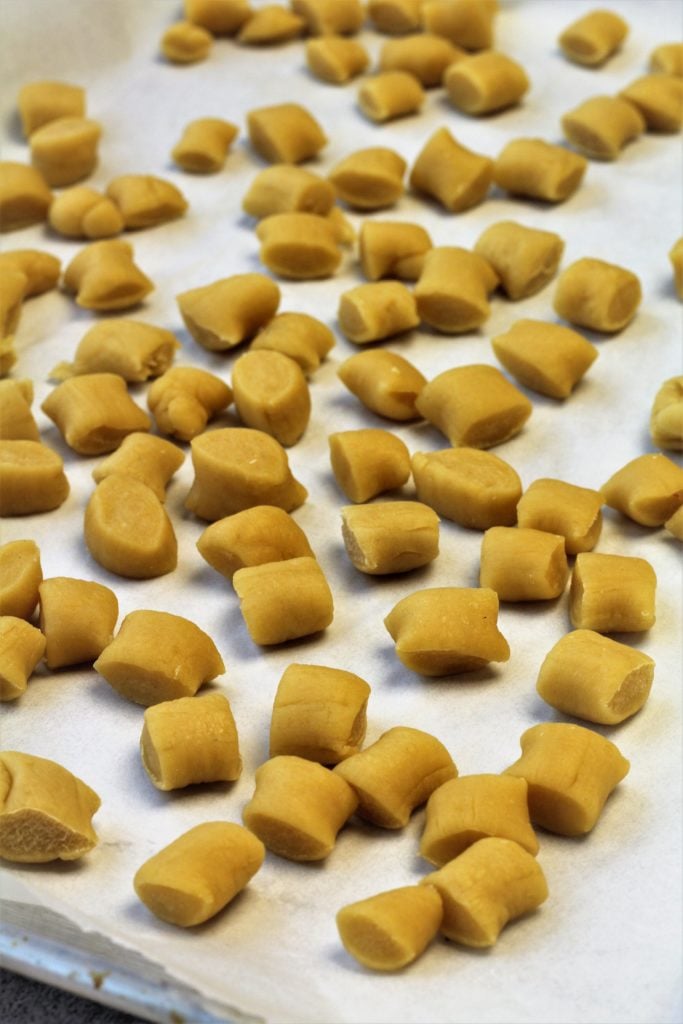
To make braided pignolata:
Use a pasta maker to flatten dough until second to last setting. If the dough is slightly sticky, dust with flour. Cut into strips approximately 22 cm x 5 cm wide. Cut each strip lengthwise in 3 equal pieces without cutting through to the end. 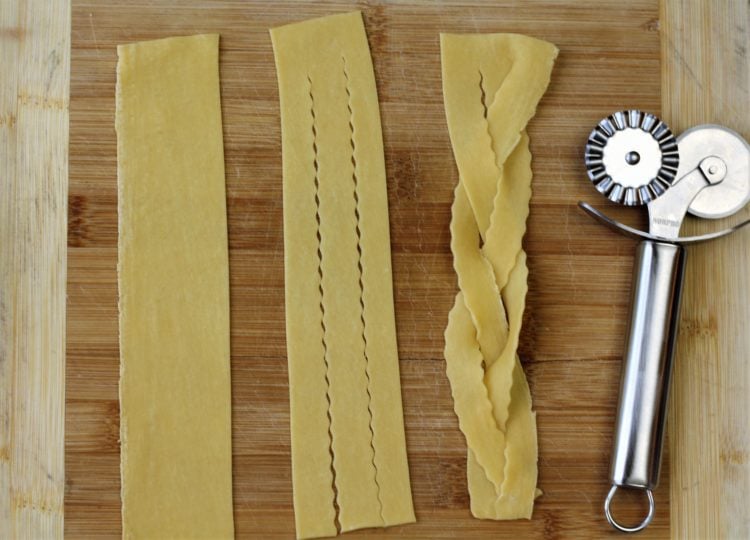
Loosely braid the strips and pinch the end together to seal. Join both ends and pinch together to form a circle.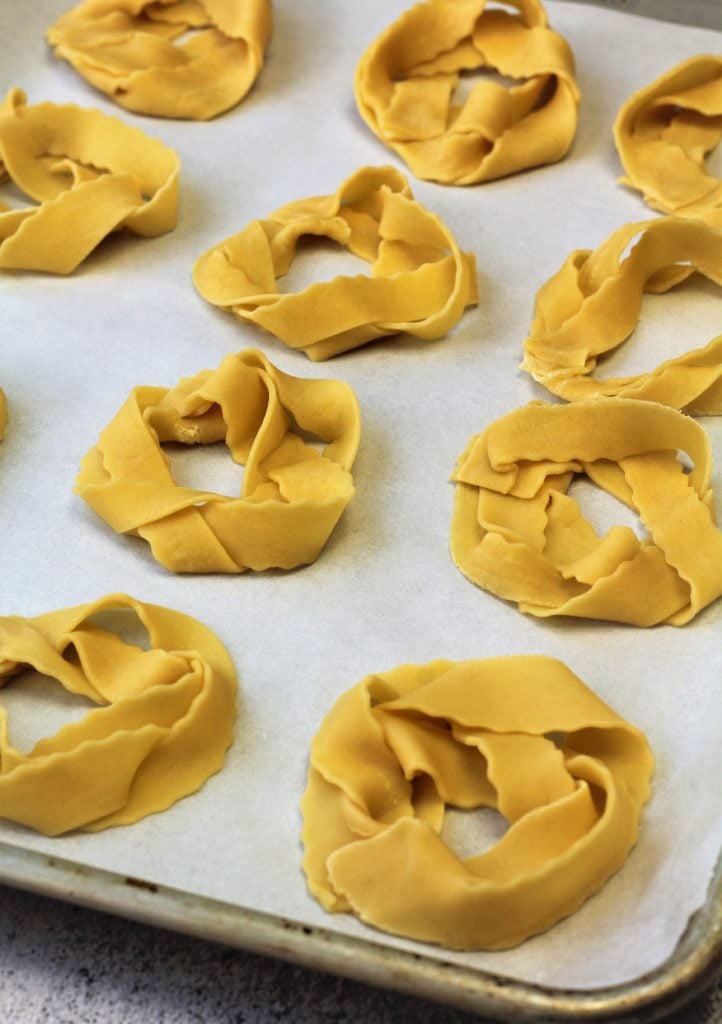
To Fry:
Heat about 2 inches of vegetable oil (canola or sunflower oil also work well) on medium-high heat in a heavy bottomed pan or your fryer. To test if the oil is hot, place a pignolata piece in the oil. If the oil immediately sizzles and bubbles around the pignolata you're ready to fry!
Fry the pignolata in batches without overcrowding your pan for 1-2 minutes until light golden brown. Transfer with a slotted spoon to a paper towel covered tray to absorb any excess oil.
Toss pignolata with honey:
Heat honey in a small sauce pan until it is runny, this only takes a minute.
Place pignolata balls or braided pignolata in a bowl. Add honey and toss to coat all pieces.
To Serve:
Once coated in the melted honey, place pignolata balls in a mound or shaped into a wreath on a serving platter and top with colored candy sprinkles.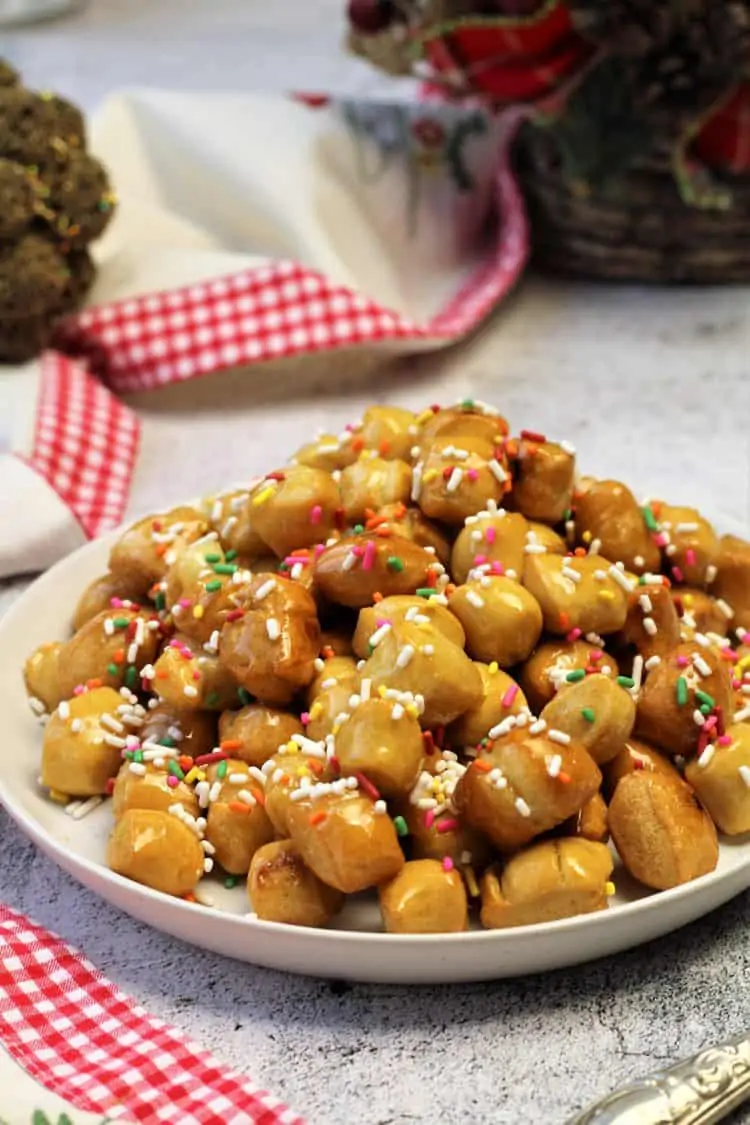
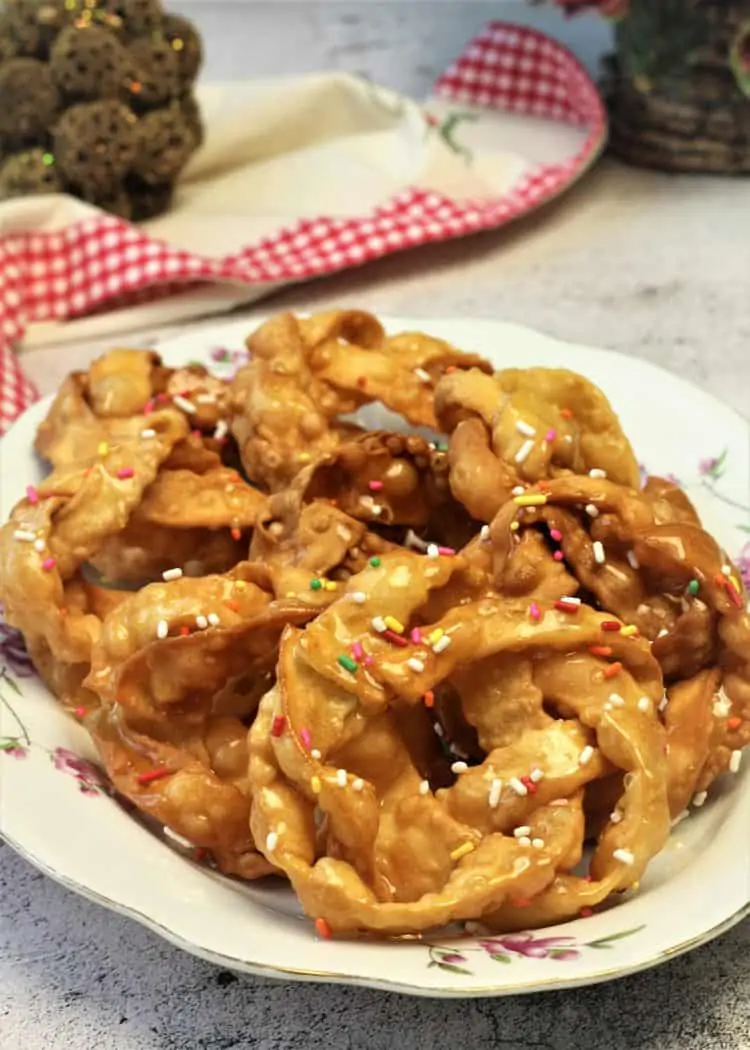
Tips and suggestions:
This recipe will make approximately 40 braided pignolata rings. Try dividing the dough in half and make half a batch of traditional ball shaped pignolata and 20 braided pignolata rings.
How long does pignolata keep for?
Quite honestly pignolata is best eaten the day you prepare it. It tends to harden as the days go by. Leftovers are best kept in an airtight container at room temperature for 2-3 days.
Can pignolata be frozen?
If you wish to prepare pignolata in advance, after it is fried and before coating with honey, freeze the pignolata pieces in a well sealed container or freezer bag for up to 1 month. Defrost at room temperature for 1-2 hours and toss with warm honey before serving.
Pignolata variations:
- Add some cinnamon to your dry ingredients.
- For more flavor, add finely grated lemon or orange zest.
- Other than candy colored sprinkles, pignolata may be topped with chopped nuts such as almonds or pine nuts or with grated chocolate.
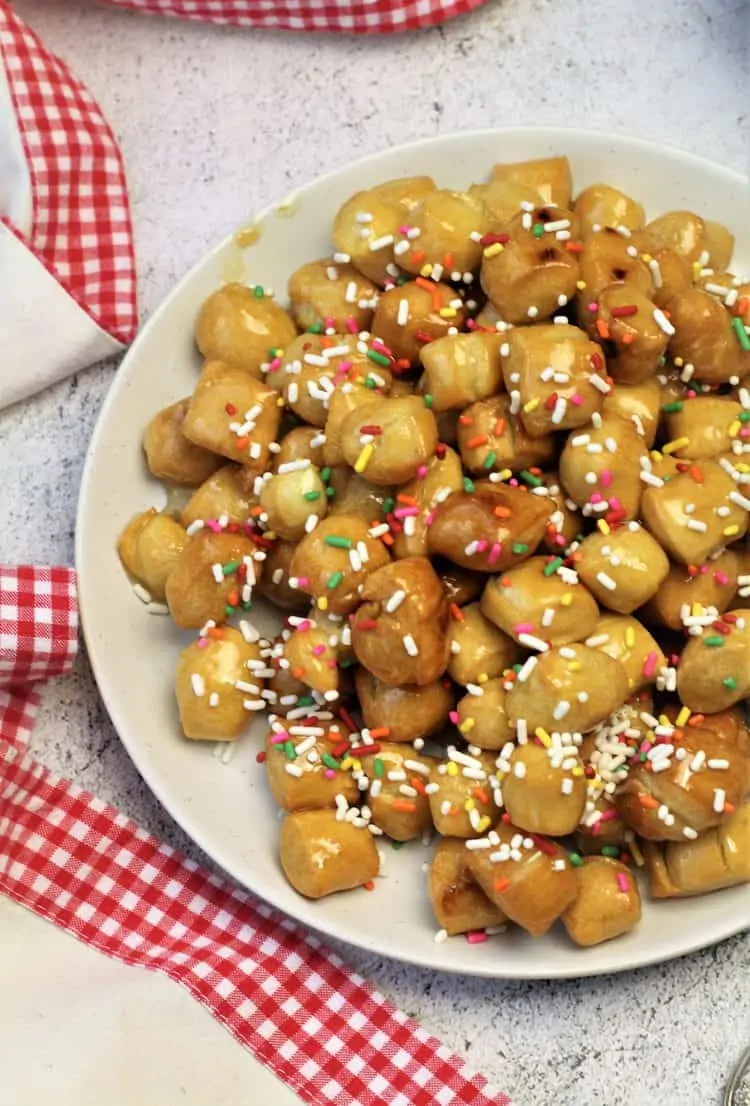
If you give this recipe a try, let me know how much you enjoyed it by rating it in the recipe card below. Feel free to Pin it for later. Buon appetito!
More holiday dessert recipes for you to check out!

Traditional Sicilian Pignolata Recipe
Ingredients
- 3 cups all-purpose flour
- 3 tbsp. granulated sugar
- ¼ teaspoon salt
- 4 large eggs
- 3 tbsp. vegetable oil may be replaced with olive oil
- 1 tbsp. milk
- vegetable oil (canola or sunflower oil may be used) for frying
- 1 cup honey
- colored candy sprinkles for serving
Instructions
Prepare the dough
- Combine all dry ingredients: all-purpose flour; sugar and salt either in a bowl or in a mound directly on your counter.
- Make a well in the center and add eggs; vegetable oil and milk. Use a fork to beat the eggs and slowly incorporate the flour into the wet ingredients until a raggedy dough is shaped.
- Transfer to your counter and knead until smooth dough is formed. Cover and let rest at room temperature for 30 minutes.
Traditional method for shaping pignolata:
- Divide the dough into 4 pieces. Roll into long ropes (as you would for making gnocchi) of about 1 cm thickness. Cut into 1 cm pieces. Leave the pieces as is or if you prefer, roll into a ball.
- Transfer onto a baking sheet in a (not overlapping) to prevent from sticking together.
To make braided pignolata:
- Use a pasta maker to flatten dough until second to last setting. If the dough is sticky, dust lightly with AP flour. Cut into strips approximately 22 cm x 5 cm wide. Cut each strip lengthwise in 3 equal pieces without cutting through to the end.
- Braid the strips and pinch the end together to seal. Join both ends and pinch together to form a circle.
To fry:
- Heat about 2 inches of vegetable oil on medium-high heat in a heavy bottomed pan or your fryer. To test if the oil is hot, place a pignolata piece in the oil. If the oil immediately sizzles and bubbles around the pignolata you're ready to fry!
- Fry the pignolata in batches without overcrowding your pan for 1-2 minutes until light golden brown. Transfer with a slotted spoon to a paper towel covered tray to absorb any excess oil.
To serve pignolata:
- Heat honey in a small sauce pan until it is liquefied, this only takes about a minute.
- Place pignolata balls or braided pignolata in a bowl. Add honey and toss to coat all pieces.
- Once coated in the melted honey, place pignolata balls in a mound or shaped into a wreath on a serving platter and top with colored candy sprinkles.
Notes
How long does pignolata keep for?
Quite honestly pignolata is best eaten the day you prepare it. It tends to harden as the days go by. Leftovers are best kept in an airtight container at room temperature for 2-3 days.Can pignolata be frozen?
If you wish to prepare pignolata in advance, after it is fried and before coating with honey, freeze the pignolata pieces in a well sealed container or freezer bag for up to 1 month. Defrost at room temperature for 1-2 hours and toss with warm honey before serving.Pignolata variations:
- Add some cinnamon to your dry ingredients.
- For more flavor, add finely grated lemon or orange zest.
- Other than candy colored sprinkles, pignolata may be topped with chopped nuts such as almonds or pine nuts or with grated chocolate.


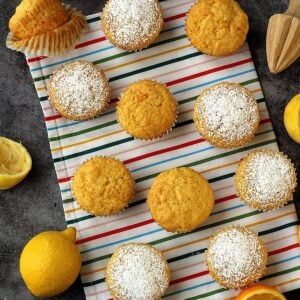
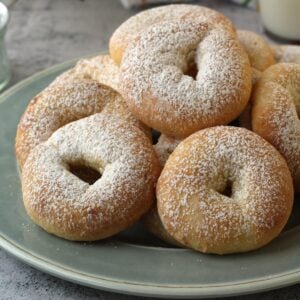
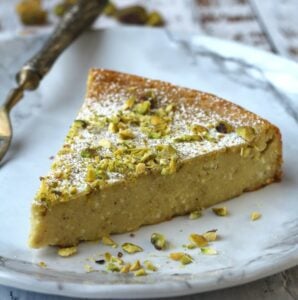
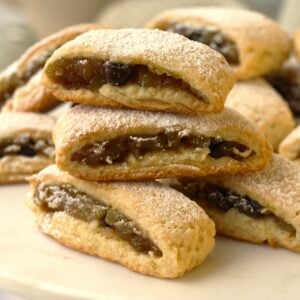
Connie
I have been trying for find this recipe ever since my mom's passing. Every year for Christmas we all waited for her pignolata. Grandchildren included. I finally came across your recipe and I must say "it is spot on". Just made this with my daughter, simple and easy instructions to follow. Thank you so much for sharing this recipe.
Nadia
Hello Connie, this was a tradition for my family made by my aunt each year and I also had not had any in years! I'm so glad you enjoyed it and it is as you expected. Thank you and happy holidays to you and yours!
Frank
I love these little honey balls! My grandmother used to make them for Christmas, although she was from Campania where as I'm sure you know they are also very popular. We knew them as stuffoli. Any differences I wonder? Recipe sounds pretty much the same.
Frank
Sorry, *struffoli* with an "r", not stuffoli...
Nadia
Hello Frank, there are endless names for this recipe as well as ingredient variations. However the concept is always the same and they are without a doubt all delicious. How could fried dough covered in honey not be good, right? Thanks!
Anna Bucciarelli
It would not be Christmas (or Easter) without these, except we call them by another name - the braided ones mama called 'scartellate' and the little balls called 'strufelle'(spelling for both is questionable), and so I and all my siblings call them. Your recipe is pretty much the same as ours except we do not add any sugar to the dry ingredients. Mama used to make huge batches of the scartellate to give as gifts. I think they keep pretty well. I say that because with the huge amounts that mama made we had them hanging around well past the holidays and still they were delicious.
Nadia
Hi Anna, it was always the same for us but no matter what you call them they're all so good! I never heard of the scartellate word however I know of cartellate which my husband's family from Bari prepares, except they are usually coated with vin cotto. So many wonderful recipes to learn about! Thank you, as always, for your lovely input!
Janet Contursi
Nice! We called them struffoli and made them every year!
Nadia
Hi Janet, they are called in so many ways but they're all delicious!